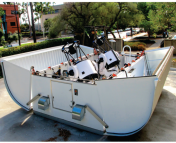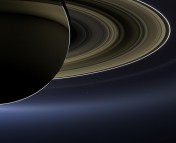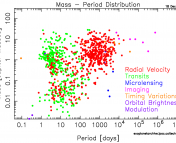Title: Stellar Spectroscopy in the Near-infrared with a Laser Frequency Comb
Authors: A. J. Metcalf, T. Anderson, C. F. Bender, et al.
Corresponding Author: S. Mahadevan
First Author’s Institution: Department of Physics, University of Colorado
Corresponding Author’s Institution: Department of Astronomy & Astrophysics, Pennsylvania State University
Status: Accepted to Optica, open access on arXiv
Our generation is the first to know with certainty that not only do other planetary systems exist, they are common throughout the Galaxy. The detailed characterization of these worlds offers up an extremely exciting possibility – the detection of life elsewhere in the Universe. However significant technological challenges remain for the detection of true Earth-like planets orbiting in habitable zones, the region where liquid water might exist on a planet’s surface. Now, a team of researchers from the National Institute of Standards and Technology (NIST), Pennsylvania State University and the University of Colorado has combined a near-infrared spectrograph and a new laser frequency ‘Astrocomb’ to dramatically improve the precision of infrared radial velocity measurements used to detect planets around nearby stars.

Figure 1: An artist’s impression of an Earth-like planet orbiting a small, cool M dwarf star. Image credit: ESO/M. Kornmesser.
Although we often describe planets as orbiting around their host stars, in reality both the star and planet have mass and therefore both bodies orbit the common centre of mass of the system. This tiny wobble of the star due to the gravitational tug of its unseen companion can in principle be detected using the Doppler shift of stellar spectral features; as the light from a source approaches or recedes from the observer, it is shifted towards shorter or longer wavelengths respectively, allowing us to infer the presence of a planet. Radial velocity measurements have played, and continue to play, a crucial role in exoplanetary research ever since they were used to make the first exoplanet discoveries and a large fraction of the known exoplanet population was discovered using these methods. The method works best for large, Jupiter-like gas giants where measured radial velocities of 10 or more metres per second are routinely observed. For small, rocky planets similar to the Earth the corresponding motion of the star produces radial velocities of about 1 metre per second or lower, about the same as walking speed! These are challenging observations owing both to the extreme mass difference of the planet and star and the distance at which the planet orbits. We can therefore mitigate some of these difficulties by searching for planets around smaller, low mass stars.
Pale red dots
Red dwarf (or M dwarf) stars are the smallest, coolest, and most common type of main sequence star in the Galaxy and emit most of their radiation in the infrared. They are abundant near the Earth and previous studies have already shown that many of them should harbour Earth-sized planets in their habitable zones (see this astrobite for details). The intrinsic dimness of M dwarfs and their high frequency of spots and flares imposes limitations on the precision of Doppler measurements in the visible and therefore requires the use of infrared wavelengths where the stars are brighter and less active. Unfortunately these observations are themselves hampered by variable low-level absorption by molecules in the Earth’s atmosphere. In general, precision at infrared is worse than in the visible, ranging from about 5 – 10 metres per second. Despite these limitations M dwarf stars offer a number of advantages when searching for Earth-mass planets. Their lower mass means lower detectable planetary masses for the same radial velocity amplitude. In addition, because they have a lower luminosity, the habitable zone is closer to the host star placing it in a more accessible region for both radial velocity and transit surveys.

Figure 2: The NIST laser frequency comb designed to provide a precise calibration grid for infrared radial velocity measurements Image credit: NIST.
Introducing the ‘Astrocomb’
The Habitable Zone Planet Finder (HPF) is located at McDonald Observatory at the University of Texas at Austin, and consists of a combination of laser frequency comb, a precise tool for measuring frequencies of light, and high precision near-infrared spectrograph mounted at the 10-meter Hobby Eberly Telescope. The instrument setup is aimed at overcoming some of the difficulties associated with infrared spectroscopy and is specifically tuned to detect habitable zone planets around M dwarf stars. The Astrocomb component was custom-built by NIST and incorporates many widely spaced ‘teeth’ or lines of equally spaced frequencies, and covers the near-infrared wavelength range of 700 – 1600 nm. The comb functions somewhat like an ultra-stable ruler to accurately calibrate and track periodic changes in the light from the star allowing for very precise radial velocity measurements. Whilst frequency combs are already in operation at other telescopes such as in conjunction with the High Accuracy Radial Velocity Planet Searcher (HARPS), this is the first to operate at infrared wavelengths.

Figure 3: Diagram showing the instrument setup. light from the Hobby-Eberly Telescope and frequency comb are coupled to the Habitable Zone Planet Finder spectrograph producing unprecedented near-infrared radial velocity precision. Figure 1 in the paper.
So far the team has managed to demonstrate radial velocity precisions of as little as 1.53 metres per second using the HPF-Astrocomb combination during observations of Barnard’s Star, one of the closest stars to the Sun, representing a significant improvement on that previously achieved in the near-infrared and approaching values measured with the more mature HARPS spectrograph. This demonstrates the ability of the HPF to reach the high level of precision necessary to detect Earth-mass planets in the habitable zones of nearby, cool stars.
The mere positioning of an Earth-mass planet within the habitable zone of a star is not however the only factor that determines its suitability for life and a number of studies have pointed out the complications to habitability posed by M dwarfs such as tidally locked orbits, a lack of sufficient UV photons to sustain photosynthesis and frequent flares capable of completely sterilizing close-in planets. However we know that life on Earth is nothing if not tenacious and we can hope that the same might also be true elsewhere. Either way the HPF along with other planet detecting instruments should provide plenty of interesting targets for observation with the forthcoming James Webb Space Telescope, designed to examine the atmospheric chemistry of these planets and potentially capable of detecting biosignatures.




